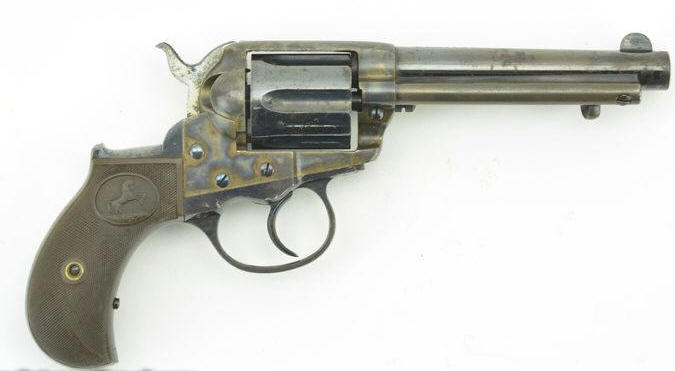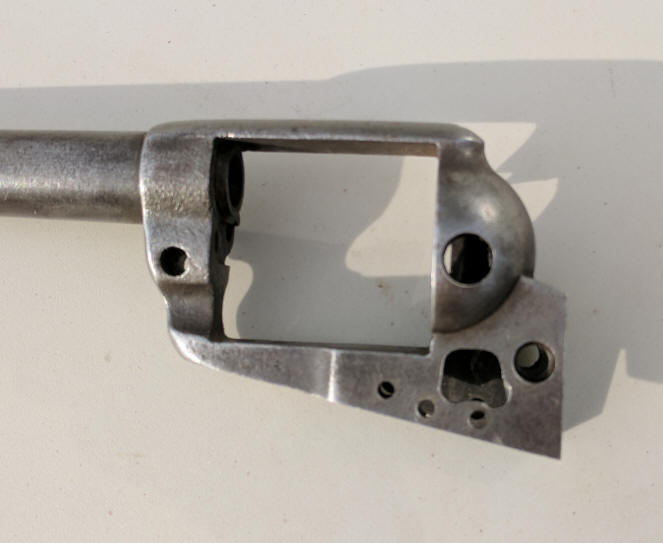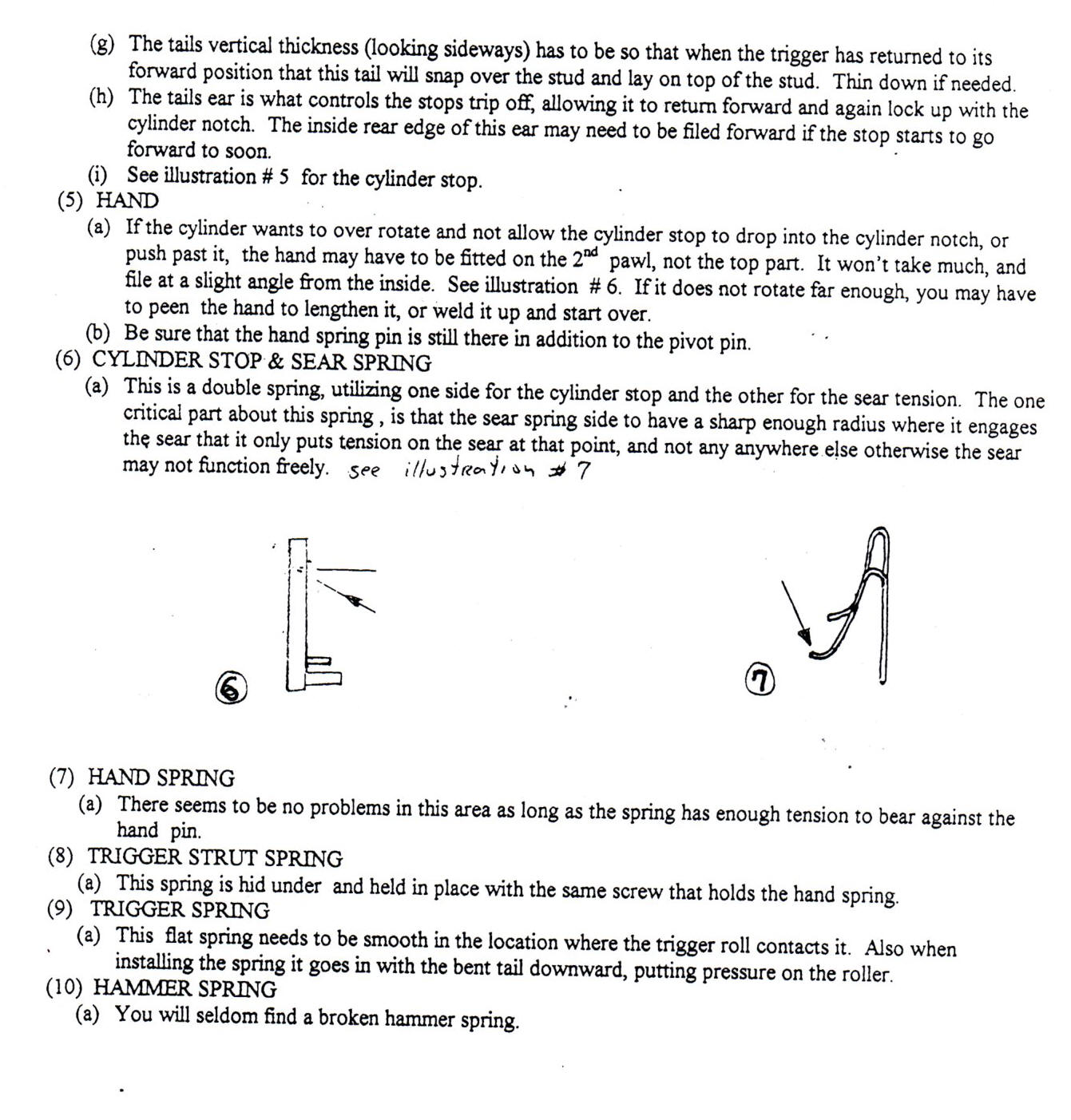
| Gunsmithing the Colt 1877 Double Action Revolver |

FIREARMS INFORMATION
The Colt model 1877 revolver was the first successful US-made double-action cartridge revolver and was from January 1877 to 1909 for a total of 166,849 revolvers. This Model was offered in three calibers, which lent them three unofficial names: the "Lightning", the "Thunderer", and the "Rainmaker".
Calibers & Configurations : The principal difference between the models was the cartridge in which they were chambered: the "Lightning" being chambered in .38 Long Colt, and the "Thunderer" in .41 Colt. Both models had a six-round ammunition capacity. An earlier model in .32 Colt known as the "Rainmaker" was only offered in 1877.
History : The model 1877 was offered from the factory in two basic finishes, nickel-plated or a case-hardened frame with a blue barrel and cylinder. This revolver was available in barrel lengths from 2.5" to 7.5" and was available with or without the ejector rod and housing. The shorter barreled versions without the ejector rod were marketed as "Sheriff's or Shopkeeper's Model".
Neither "Lightning" nor "Thunderer" were Colt designations, nor used by the factory in any reference materials, but nicknames added by others.
The model 1877's early double-action mechanism proved to be both intricate and delicate, and thus prone to breakage. The design had a reputation for failure and earned the nickname "the gunsmith's favorite". Because of the intricate design and difficulty of repair, gunsmiths to this day dislike working on them. Gun Digest referred to it as "the worst double-action trigger mechanism ever made". Typically, the trigger spring would fail and this would reduce the revolver to single-action fire only. Outwardly, the model 1877 shows a striking resemblance to the Colt Single Action Army revolver, however it is scaled down slightly and much thinner in dimension. The bird's head grips were of checkered rosewood on the early guns and hard rubber on the majority of later-production guns.
The "Lightning" was the favored personal weapon of famous Manchester (United Kingdom) Victorian era detective. Old West outlaw John Wesley Hardin frequently used both "Lightning" and "Thunderer" versions of the Colt 1877 revolver. Likewise the 1877 "Thunderer" in .41 caliber was the preferred weapon of Billy the Kid, and was his weapon of choice when he was killed by Pat Garrett in 1881.
For an Illustrated parts article CLICK HERE
Gunsmithing : As mentioned above, these were/are considered the "Gunsmith's Nightmare" then, and now 140 years later considerably moreso. The smart gunsmith today will simply say NO, if asked to work on one of them, saying simply that those guns being well over 100 years old were not originally designed well to start with, being the badly designed prototype of all succeeding double action revolvers. And most that have survived now are WELL worn, along with VERY LIMITED replacement parts availability. And that he may never have even been inside one, so has no idea of how the internal complicated workings function. And he could do more damage internally because the design is something totally foreign to the modern pistolsmith. The internal relationship of each part has to be fitted in a sequence to ensure material is not removed from the wrong part.
Then, for the old timers who used to work on them, most have now passed on, leaving not one even as an apprentice with any basic functionality training. One of the last gunsmiths that I knew, charged a flat rate of $500 just for repairs, and then would not guarantee that it functioned reliably as a shooter after it left his shop. So it was just a wall hanger.
OK, now for those of you who need to be convinced, I am posting 3 pages (attached below) of notes that I did probably back in the early 1990s when I was, younger, and thought I could fix anything made by man. I pretty well figured it out, but at a cost of MANY MANY HOURS of head scratching work that I could never recover anywhere near a value for my time invested, but that could be attributed to being bull headed. The only way I found out was to skeletonize a very bad gun's frame so that I could see how the internals functioned in relationship to each other. In the photo below, you can see the 5/16" dia. milled hole rearward of the cylinder opening. This allows you to see the hand to ratchet engagement. There is no need to do anything from the other side as you can see it all from this side.
Then lower, the other somewhat square hole allows you to see the trigger/sear/cylinder stop interaction. In use, you install your parts into this frame so you can tell where to fit, trim or weld metal onto.
| Colt 1877 frame sketetonised |
 |
Hopefully these will scare you off, or help you, IF you do decide to venture into the unknown.
These repairs HAVE to be done in a sequence as listed in my 3 pages of notes, shown below. For the average modern day pistolsmith, you will have to re-read these instructions many times in order to truly understand their meaning while you have your parts in and trying them. The odd part is that this model's cylinder stop notches are that they on the rear of the cylinder and not on the sides.




The author does not have any source of parts for any of the firearms listed above
Copyright © 2017 -- 2021 LeeRoy Wisner All Rights Reserved
Back to the Main Ramblings Page
Originated 08-11-2017, Last updated
12-22-2021
Contact the author